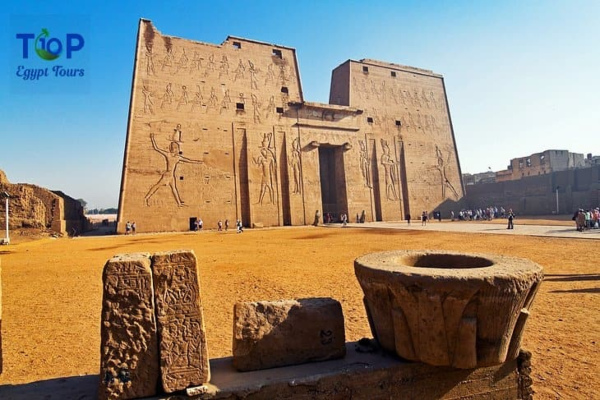Temple of Edfu, Nestled on the west bank of the Nile River in Edfu, Egypt, the Temple of Horus is one of the best-preserved ancient temples in the world. Dedicated to the falcon god Horus, the temple was built over 180 years during the Ptolemaic period (305-30 BC). The temple complex is a marvel of ancient Egyptian architecture and engineering, and its intricate reliefs and hieroglyphics provide valuable insights into the religious beliefs and practices of the time.
In this article, we will uncover for you the Temple of Edfu with Top Ten Egypt.
Architectural Splendor Temple of Edfu:
The Temple of Horus is a massive structure, measuring over 230 meters long and 130 meters wide. The temple complex is surrounded by a high enclosure wall, and its entrance is flanked by two towering pylons. The pylons are decorated with reliefs depicting the pharaoh Ptolemy XII victorious over his enemies.
Inside the temple complex, visitors can admire the grand courtyard, hypostyle hall, and sanctuary. The courtyard is surrounded by colonnades, and its walls are adorned with reliefs depicting scenes from the Horus myth. The hypostyle hall is a vast chamber supported by massive columns. The sanctuary is the innermost chamber of the temple, where the statue of Horus was once housed.
Historical Significance Of Horus Temple:
The Temple of Edfu was built on the site of an earlier temple that dates back to the Old Kingdom period (2686-2181 BC). The Ptolemaic pharaohs believed that Edfu was the birthplace of Horus, and they commissioned the construction of the temple to honor the deity.
The Temple of Horus played an important role in the religious life of ancient Egypt. It was the center of the Horus cult, and it was a popular pilgrimage site for people from all over the country. The temple was also a center of learning, and its priests were skilled in astronomy, mathematics, and medicine.
Cultural Heritage Preservation Of Edfu Temple:
Temple of Edfu was buried in the sand for centuries, and it was not until the 19th century that it was excavated by French archaeologists. The temple was carefully restored, and it is now one of the most popular tourist attractions in Egypt.
The Egyptian government has taken steps to preserve the Temple of Horus for future generations. The temple complex is surrounded by a buffer zone to protect it from development, and regular maintenance and restoration work is carried out to ensure that the temple remains in good condition.
Artistic Treasures:
The Temple of Horus is adorned with exquisite reliefs and hieroglyphics. The reliefs depict scenes from the Horus myth, as well as religious rituals and historical events. The hieroglyphics provide insights into the religious beliefs and practices of the Ptolemaic period.
Some of the most notable artistic treasures at the Temple of Horus include:
- The relief on the south pylon depicts Ptolemy XII defeating his enemies.
- The relief on the north pylon depicts Ptolemy XII presenting offerings to Horus.
- The relief on the east wall of the courtyard depicts the Horus myth.
- The reliefs on the walls of the hypostyle hall depict religious rituals and historical events.
- The hieroglyphic inscriptions on the walls of the sanctuary.
Cultural Experience and Connection:
A visit to the Temple of Horus offers visitors a unique opportunity to experience the ancient Egyptian culture. The temple’s grand architecture, intricate reliefs, and hieroglyphics transport visitors to a bygone era.
Visitors can learn about the religious beliefs and practices of the Ptolemaic period, and they can gain a deeper appreciation for the artistic achievements of ancient Egypt. The Temple of Horus is also a reminder of the rich cultural heritage that Egypt shares with the world.
The Temple of Edfu is a must-see for any visitor to Egypt through the Aswan Day Tour. It is one of the best-preserved ancient temples in the world, and it offers a unique glimpse into the religious beliefs, cultural practices, and artistic achievements of ancient Egypt.
Browse our complete list of Egypt tours and join our Aswan Day Tour To Kom Ombo and Edfu Temples.



Comment (0)